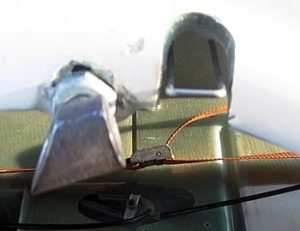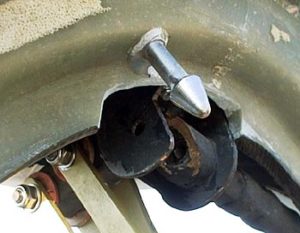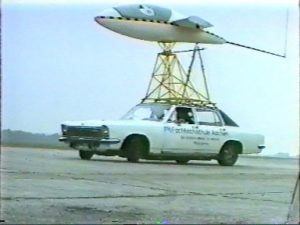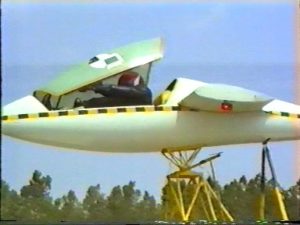Almost all sailplane pilots wear parachutes when flying. Naturally, we do not expect to ever use them, but we don’t want to take unnecessary risks. But in an emergency the parachute is only useful if the pilot can leave the cockpit of a probably uncontrollable sailplane. But that is often a problem.
We have reported extensively on the NOAH system, but just like a rocket assist, it presumes that the canopy has first been ejected. But there are two known situations when that is not possible. Sometimes the canopy moves back a bit in an emergency ejection and then gets pushed down in the airstreams to such an extent that the pilot has great difficulty to shove it out of the way. That uses up valuable time. Even worse, the departing canopy can hit the pilot on the head and causes him to lose consciousness.
To avoid these situations Prof. Roeger of the Aachen University of Applied Sciences many years ago invented a special hook, since named for him. After the emergency release the hook turns on the rear canopy frame and prevents it from moving back. The airstreams flowing into the cockpit cannot escape and therefore lifts the canopy, which rotates on the Roeger hook and forces the front of the canopy to lift off and depart rearwards over the tail fin. Such a Roeger hook has been a mandatory installation in all new sailplanes for some years. Great, problem solved.
But there are still several thousand older sailplanes without a Roeger hook. In the spring of 99 a pilot in the US died after a mid-air and pulling the canopy emergency release, but remained seated in the cockpit without even undoing his seat harness. Analysis of his head wounds showed that he had been knocked unconscious by the left side of the canopy frame.
We have decided to find a solution to this problem which could be retrofitted to older sailplanes and perform the function of a Roeger hook. The hook itself can only be retrofitted at considerable expense, but a small spring loaded pin can accomplish the same purpose by fixing the canopy in the rear position until the slipstream lifts the front of the canopy over the pilot. For that we need a strength of about 8 KG according to the experiements of Prof. Roeger.
We offer this solution to all pilots and sailplanes of the series DG-100, DG-200, DG-300, DG-400 and DG-600 as well as LS4 to LS8 which do not have a Roeger hook as a retrofittable substitute. A Technical Note for LS1 and LS3 is under construction.
| Technical Drawing-1 | Technical Drawing 2 |
|
|
 |
 |
|
Dear pilots of the above mentioned DG and LS single seaters:
None of you should fly next season
without this safety improvement in his sailplane.
Technical bulletin # 301-21 for DG gliders can be downloaded
Retrofitting of Roeger hook and canopy lift spring for older versions of LS gliders
An explanation by Wilhelm Dirks
It is well established, that Prof. Roeger at the University of Aachen, did quite a lot of tests with a LS fuselage in order to examine the canopy drop during flight. The deflating results of those tests can be read in a project report.
The test program showed that the canopies did not fall apart the fuselage due to aerodynamic reasons or even hit the pilot during the drop causing heavy injuries. As a result of these tests, the well-known “Roeger-Hook” was developed. But furthermore the canopy had to be lifted upwards in the front by the pilot. This issue then was solved by combining the Roeger hook with a lift up spring enabling a safe drop of the canopy.
These requirements, of cause, were then included in the building code for sailplanes and motor gliders (JAR22, CS22).
Rolladen Schneider immediately modified their state of the art sailplanes but unfortunately didn’t carry out a solution to retrofit older LS types.
DG was informed about this problem by multiple experts. As a result we developed the Technical Note for old LS gliders. Even the judicial side is enough to force us developing a solution. Think about claims for compensation because a bail-out was not possible and DG knows about this problem all the time.
A lot of pilots ask us:
“Do we need to adhere to the Technical Note for LS canopies?
EASA Part M clearly states out that maintenance has to be done strictly according to the type certificate holder’s documentation. So all actions declared as mandatory in the Technical Note have to be carried out.
Part M regularizes all matters dealing with maintenance and inspections for non-commercial aircraft below 5.7 tons.
M.A.401 a) regularizes that maintenance has to be carried out by the latest maintenance documentation (including Technical Notes) and M.A.401 c) regularizes that all personnel or maintenance companies doing maintenance on the glider have to ensure that maintenance documentation is at the latest standard.
Regarding the inspection of airworthiness, M.A.710 a) 10. states out that it has to be checked that the aircraft is equipped according to the latest standard approved by EASA.
Judicial position for inspectors:
The airworthiness inspector has to check the current situation of Technical Notes and Airworthiness Directives for the aircraft he inspects and if all binding actions have been done before he is allowed to sign a new ARC.
In case the deadline for binding actions has passed and an ARC is handed out anyway, the inspector commits an administrative offense. Also, in case of a crash he can be prosecuted in case the ignored actions might have changed the crash’s results.
The new and re-worked Technical Notes (Canopy-Ejection) for LS-gliders you find below:
- 61 for LS1-f
- 3054 for all LS3
- 4032 for LS4 und LS4a
- 6025 for LS6, LS6a, LS6b, LS6c
- 7009 for LS7 (not LS7-WL
The previously issued Technical Notes on this subject were revoked.
This is not amusing…
(…a remark of the year 2001 and still vaild!)
I published the preceding article a year ago on both the Internet and twice in pilot newsletters. I assume that just about every DG owner has seen this article and heard about our offer.
Last year was not a good one…., my friend was killed accidentally.
Furthermore in the USA a pilot forgot to secure the main pin and, as a consequence, had to bail out. He was lucky that the aircraft was, more or less, in control and he was able to egress in text-book fashion without being hit by the canopy.
Did you know that: 50% of all attempts to bail out are fatal. A large part of this statistic stems from “interference” between the pilot and the canopy once it is released. Why bother wearing a parachute if you don’t maximize your chances and install a Roeger Hook?
Why do I say this?
Well, what do you think about the following:
We have built about 1,400 single-seat DGs before the introduction of the Roeger Hook and every owner should have installed the new device within the last 12 months. Of course I had no illusions that everyone would install “Roeger Pins” in their aircraft. If only 2/3 of the owners would retrofit this cheap, inexpensive life-saving device I would consider this a success.
And how many do you think we sold in the last year????
Twenty eight units only – 2% of the gliders!
This is not very impressive is it?
In the meantime we have developed another safety device, similarly inexpensive, and equally as effective. It is a world-first. This device was the brainchild of the famous soaring instructor Derek Piggott and is named the “Piggott Hook” in his honor. He has asked us to offer a retrofit for all of our older gliders. Normally, it is self-evident that we would do this.
NO SIR! No Longer!
I cannot impose my own opinion and will on Company matters, no matter how altruistic. If a device is to be designed and produced it must be marketable.
I have provided the inexpensive technology.
If YOU are not willing to invest in YOUR own safety……
How can I possibly help you?
Now I can understand my competitors who sometimes may have thought:
“Mr. Weber is new to this business and has naive notions. He will figure it out sooner or later!”
Or as the representative of a competitor wrote me some years ago:
“Friedel, you are learning a very important thing: Safety Does Not Sell!”
Unfortunately, he is right.
– friedel weber –
Betreff: DG Roeger Hook
Von: “Bob Brown”
Dear Karl,
your provision of the Roeger Hook safety modification for all older DG gliders is a significant move to improve safety in gliding.
As you say it ensures that escape from the aircraft is not prevented by the canopy, nor does the canopy inflict any injury on the pilot.
The suggested cost is not a barrier to fitment. However many pilots are not happy or not competent
to carry out structural changes to their aircraft.
In addition people often think, ” that’s a good idea”, when they read about something, but then do nothing about it.
I believe that this modification falls into the above.
Is there an answer?
I believe that there is!
In my industry we have product amendments which fall into the category of recommended changes.
These are discussed with the customer by our Agent/Dealer in terms of applicability to their model, cost etc.
May I suggest that DG send a note to all of your agents suggesting that at the next annual inspection
this modification is a recommended change. Thus when the owner presents his aircraft for its next “annual”,
and he and the agent discuss any additional work to be carried out, this modification will be considered.
I believe that very few people would reject the modification as:-
– it is a definite safety improvement
– would not add a significant cost to the “annual”
– it would carry the approval of the local agent, whose judgment the owner usually trusts
The benefit of the above is that it brings the improvement to the owners attention at a time
when it can be carried out with no inconvenience to the owner.
It is a good idea. DG just need to “sell it” to the owner at the appropriate time.
Keep up the good work and do not let people’s inertia deflect you.
Use your network of agents to sell these and any other innovations to the owners of DG gliders.
Yours
Bob Brown
Thank you for this advice.
Of course we already asked our representatives, to “sell” these items.
Professor Roeger’s research project
The recognized problems and the possible solutions had been clearly described in the earlier article by Herrn Fendt of the LBA (German civil aviation authority). I hadn’t known exactly how the experiments were conducted or what astounding results were produced however. Roughly 5 years had passed since the article was first published, there were as good as zero orders for retrofitting the canopy safety device “Roeger-Hook”, which makes one wonder considering the very clear comments to be found above in this article.
A customer, Jürgen Riel, brought the subject to the fore once again and I called Professor Roeger who immediately made a DVD of the original films available. There are many gigabytes of data and it’s not possible to publish it all here, but you can see several short video clips of the most relevant and important scenes and results.
Here follows a heavily edited version of the results of Professor Roeger’s research project. This project was supported by the German Ministry of Transport in cooperation with the Luftfahrt-Bundesamt (German civil aviation authority) in order to further our safety as Sailplane Pilots.
As you have already read above there followed a comprehensive theoretical document including wind tunnel tests based on the following requirement:
The time required to evacuate a sailplane must be significantly reduced!
It consisted essentially of the following points:
- That the canopy jettison systems are all different and often confusing for the pilot in an emergency situation.
- That a canopy with an optimal aerodynamic shape for jettisoning made it virtually impossible for the pilot to get out
- That particularly older pilots had hardly any chance to evacuate the aircraft quickly enough under a load of 1.5G.
An enormous amount of fundamental experiments would have to be made, because at that time there was practically no basic knowledge of the situation.
In the end the experiments leading to the “invention” of the hook which has ever since been named after Professor Roeger were spectacular and interesting. On a becalmed airfield with a 2Km concrete runway, a somewhat strange looking contraption was set in
At first experiments were conducted where the canopy was simply unlocked. It stayed on the fuselage up to a speed of 160Kph. A spring which lifted the
front of the canopy to let the air stream in and allow the canopy to “fly away” also came to nothing without the later development of the Roeger Hook.
Along with these results comes a scarcely believable but true anecdote:
Walter Schneider, at that time head of Rolladen Schneider, simply didn’t want to believe that the canopy lay still without moving and didn’t fly away even with the front lifted. He repeated the experiments at his own cost at the Airfield at Egelsbach. Unfortunately the airfield was too short. He pulled some strings and got the use of “Startbahn-West” a main runway at Frankfurt International Airport for the experiments! This runway was long enough, and eventually even Walter Schneider was convinced…..
Next a pilot was put in the fuselage in order to create a real jettison situation. Watch the last few seconds carefully:
When the canopy eventually flies away, he’s hit in the head by it. Without the helmet he’d probably have been in no condition to do anything afterwards.
The theoretical preliminary experiments had indicated a solution:
Hold the rear edge of the canopy fast. That could have been realized by adding a weight of over 6 Kg (which probably wouldn’t have been very popular) or with a hook. The Roeger Hook was born!
The positive benefits of the Roeger Hook were absolutely clear to all the participants in the experiments as well as to the LBA. The Roeger Hook was made compulsory equipment for all new aircraft with front hinged canopies.
Of course you cant simply mount such a hook in a fixed way, because then the canopy couldn’t be shut anymore. A mechanism is needed which, for example, swings a hook under the canopy frame when the jettison handle is pulled. Such a solution can only be implemented during initial construction, but is offered by all manufacturers with front hinged canopies.
The experiments weren’t conducted until the end of the eighties and many aircraft are still flying today without this important safety feature. Unfortunately it’s only possible to retrofit a “real” Roeger Hook with considerable effort, however we have developed a “Retro Roeger Hook” (the Canopy Safety Device, see above).
The Roeger Hook is a typical example of a very important development whose necessity hardly anyone had previously recognized for the simple reason that the physical realities just weren’t believed. Eventually an idea, a scientific institute with a dedicated director, and the resources of the Ministry came together and this simple but never the less exceedingly important solution was developed. To subsequently name the hook after it’s inventor is certainly a sign of appropriate appreciation of his work and that of his team.
A comment on side hinged canopies:
With reference to the film clips, they are significantly inferior in comparison to forward hinged canopies. The best solution for side opening canopies is to have a weak point in the hinge. When it breaks, the canopy flies away without a problem. It’s just that the weak point has to be so weakly dimensioned that it wouldn’t be adequately strong for daily service.
If you make it strong enough for daily duty, there’s always the danger, as seen in a two seater accident, that the canopy didn’t fly away at all and the pilot had massive difficulty in getting out, if indeed it’s possible to get out. The two canopies of a DG-1000 are certainly easier to open than a large single one would be. They are however, due to being side opening, definitely less safe than those on our single seaters. Unfortunately we cant hinge them forward and aft, because the chamfer of the canopy opening doesn’t allow opening upwards. If we wanted to change that, a whole new fuselage would be required. Perhaps the ideal solution would be a jettison handle which freed only the forward hinge, the canopy would thereby turn in the wind such that the rear hinge would break on it’s own despite being relatively heavily built. We’ll have to wait and see……anyway the necessity of an emergency exit from two seaters is, for obvious reasons, much rarer than for single seaters.
Jettisoning a side opening canopy from a single seater is, after pulling the jettison handle, comparable with jettisoning a front hinged canopy without a Roeger Hook with all the problems described above. That such canopies are still offered on single seaters ( which it’s more common to have to jump from than double seaters) is remarkable, isn’t it?
“It still takes too long!”
That’s the summary of the films on the DVD from Professor Roeger. It would take an emergency exit system or a rocket powered recovery system to make a
timely exit possible for pilots especially under high G loading. The rescue system SOTEIRA is not yet available, but in the meantime there is our NOAH which makes emergency exit within scarcely more than a second possible. This supplies a relatively safe technique for leaving a crippled aircraft. The pilots just have to be prepared to invest in their own safety, otherwise you can only draw the bitter conclusion “Safety doesn’t sell”.




